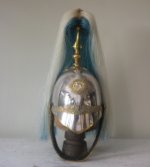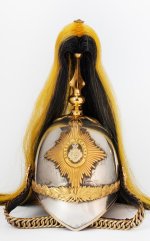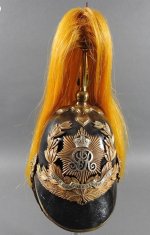Yeohelmetguy
Well-known member
This post focuses on an 1871 pattern troopers' helmet to the 2nd County of London, Westminster Dragoons regiment.
The 2nd County of London, Westminster Dragoons was a yeomanry regiment of the British Army reserve located in Central London. Its lineage is continued by one of the Royal Yeomanry's six squadrons. Formed in the aftermath of Second Boer War as part of the County of London Yeomanry, the Westminster Dragoons fought in the Battle of Gallipoli and in World War Two led British forces onto the beaches during the Normandy Invasion in 1944. The squadron most recently saw action on Operation Telic for which it was mobilized for the 2003 war in Iraq.
Following a string of defeats during the Second Boer War known as “Black Week” in early December 1899, the British government realized that it would need more troops to re-enforce the regular army to fight the Boers. On 13 December of that year, the decision to allow volunteer forces to serve in South Africa was made, and a Royal Warrant was issued on 24 December that officially created the Imperial Yeomanry. The force was organized as county service companies of approximately 115 men each who signed up for one year service, and volunteers from the yeomanry cavalry and civilians (usually middle and upper class) quickly filled the new force, which was equipped to operate as mounted infantry. Second and third contingents were sent out in the following years.
One such unit was the 24th (Metropolitan Mounted Rifles) Battalion, consisting of 94th, 95th, 96th and 97th (Metropolitan Mounted Rifles) Companies raised in London for the second contingent on 30 March 1901. Later in 1901 the 28th (Westminster Dragoons) Battalion, was raised, with the Westminster Dragoons forming Companies 127 through 130.
In 1901, 16 new Imperial Yeomanry regiments were raised from veterans of the first Imperial Yeomanry contingent returning from South Africa were added to the existing Yeomanry Cavalry. The 2nd County of London Imperial Yeomanry was formed on 24 August 1901 with four squadrons and a machine gun section, perpetuating the 24th (Metropolitan Mounted Rifles) Battalion. Over 800 members of the regiment served in South Africa, and the regiment was awarded the battle honor South Africa 1902. On 2 August 1902 the Westminster Council granted permission for the regiment to adopt the subtitle “Westminster Dragoons” to perpetuate the 1779-1829 units, the London and Westminster Light Horse (1779) and the Westminster Volunteer Cavalry (1797) and to use the city's coat-of-arms as its cap badge. King Edward VII approved this addition early the following year.
From the start it was smart regiment filled with wealthy gentlemen from the city and the West End. Their attitude and attire were such that, as they strutted across West London, members became known as the 'Piccadilly Peacocks'. Several of the unit's first officers were former officers of the 1st Royal Dragoons, forerunners of the Blues and Royals; one of the first troop leaders was Raj Rajendra Narayan, Maharaj Kumar (Prince) of Cooch Behar. They brought with them the Royals' Pre-Waterloo cap badge, which was later adopted by Colonels and Brigadiers of the staff, which is why, until a common Royal Yeomanry cap badge was adopted in 2006, young Westminster Dragoon officers often found themselves amused at being saluted by officers of higher rank. The Westminster Dragoons stable belt (worn in barracks) bears the Royal racing colors of imperial hues of purple, gold and scarlet as a result of the personal friendship of its first commanding officer, Colonel Charles Rosedew Burn, with King Edward VII, whose Aide-de-Camp Burn had been when he was Prince of Wales.
As an urban regiment, the yeomen were unable to supply their own horses, so the senior Westminster officers made use of their links to the highest ranks of Society to borrow mounts from the Household Cavalry for summer training camps. Later horses were hired. Even at this time, the Westminster Dragoons were at the forefront of using new equipment, being the second unit in the British army after the Westmoreland and Cumberland Yeomanry to be equipped with mobile wireless. In 1910, Lord Howard de Walden presented two Marconi pack sets to the regiment.
In 1907 the Regimental Headquarters was at 102 Victoria Street, but by 1914 it had moved to 1 Elverton Street, Westminster. When the Imperial Yeomanry were merged into the new Territorial Force under the Haldane Reforms of 1908, the regiment simply dropped 'Imperial' from its title. It was attached to the London Mounted Brigade for training but was otherwise under the command of London District.
The Westminster Dragoons' summer camp in 1914 was at Goring-on-Thames. It began on 25 July, but the regiment was recalled to Westminster when mobilization orders arrived on 5 August on the beginning of World War One. The regiment reorganized on the three-squadron basis used by the Regular cavalry and purchased its own horses. The regiment served in Egypt, Gallipoli, Palestine and on the Western Front
After World War One the Westminster Dragoons again, embraced new technology, making the decision to become an armored car unit at a time when many yeomanry units were determined to remain mounted. The decision to accept immediate conversion was that of its then commanding officer, Lord Howard de Walden. On 11 March 1920, the regiment reformed with the title 4th Armored Car Company (Westminster Dragoons), but this was quickly changed to 22nd (London) Armored Car Company (Westminster Dragoons), Tank Corps in the retitled Territorial Army, thus forming its link with the Tank Corps (Royal Tank Corps from 18 October 1923, and Royal Tank Regiment from 11 April 1939.
The armored car company was expanded to a full battalion and designated the 22nd (Westminster Dragoons) Battalion, Royal Tank Regiment in January 1938.
With the outbreak of hostilities in with the on=set of World War Two, the regiment regained its combat status on 11 November 1940, when it became 2nd County of London Yeomanry (Westminster Dragoons) in the Royal Armor Corps (RAC) – always known as simply the Westminster Dragoons. The regiment joined the newly formed 20 Armor Brigade in the 11th Armor Division on 8 March 1941. In May 1942 the brigade transferred to the 42nd Armor Division and then in October 1943 to the 79th Armor Division under Major General Percy Hobart. For the planned Normandy Invasion, Operation Overlord, the 30th Armored became the “Flail” tank brigade of the division. For the assault landings the Westminster Dragoons were under the command of the 50th (Northumbrian) Division on Gold Beach with A Squadron detached under the command of the 22nd Dragoons to work with 3rd Canadian Division on Juno Beach and the 3rd British Division on Sword Beach. The Westminster Dragoons Fought with several division throughout the Second World War through the Netherlands and Germany.
This helmet, from my collection is an 1871 pattern dragoon troopers' helmet to the 2nd County of London, Westminster Dragoons as worn during its association with the Imperial Yeomanry from 1901 through 1910, see the “IY” initials to the front of the helmet plate. It displays its correct purple plume which was change to white in 1911 because the purple dye was not color fast and prone to fading and the color “running’ when it became excessively in the rain wet!
Thanks all for looking. I hope you enjoy the helmet and the brief history lesson!
Regards to all,
David
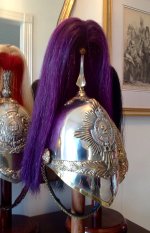
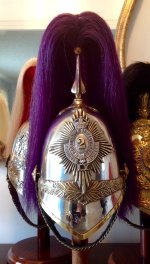
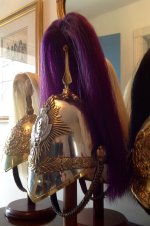
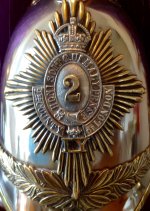
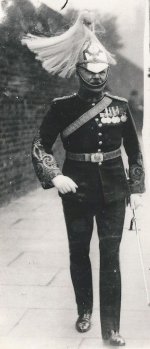
Colonel of the Westminster Dragoons, 1911 with white plumed helmet
The 2nd County of London, Westminster Dragoons was a yeomanry regiment of the British Army reserve located in Central London. Its lineage is continued by one of the Royal Yeomanry's six squadrons. Formed in the aftermath of Second Boer War as part of the County of London Yeomanry, the Westminster Dragoons fought in the Battle of Gallipoli and in World War Two led British forces onto the beaches during the Normandy Invasion in 1944. The squadron most recently saw action on Operation Telic for which it was mobilized for the 2003 war in Iraq.
Following a string of defeats during the Second Boer War known as “Black Week” in early December 1899, the British government realized that it would need more troops to re-enforce the regular army to fight the Boers. On 13 December of that year, the decision to allow volunteer forces to serve in South Africa was made, and a Royal Warrant was issued on 24 December that officially created the Imperial Yeomanry. The force was organized as county service companies of approximately 115 men each who signed up for one year service, and volunteers from the yeomanry cavalry and civilians (usually middle and upper class) quickly filled the new force, which was equipped to operate as mounted infantry. Second and third contingents were sent out in the following years.
One such unit was the 24th (Metropolitan Mounted Rifles) Battalion, consisting of 94th, 95th, 96th and 97th (Metropolitan Mounted Rifles) Companies raised in London for the second contingent on 30 March 1901. Later in 1901 the 28th (Westminster Dragoons) Battalion, was raised, with the Westminster Dragoons forming Companies 127 through 130.
In 1901, 16 new Imperial Yeomanry regiments were raised from veterans of the first Imperial Yeomanry contingent returning from South Africa were added to the existing Yeomanry Cavalry. The 2nd County of London Imperial Yeomanry was formed on 24 August 1901 with four squadrons and a machine gun section, perpetuating the 24th (Metropolitan Mounted Rifles) Battalion. Over 800 members of the regiment served in South Africa, and the regiment was awarded the battle honor South Africa 1902. On 2 August 1902 the Westminster Council granted permission for the regiment to adopt the subtitle “Westminster Dragoons” to perpetuate the 1779-1829 units, the London and Westminster Light Horse (1779) and the Westminster Volunteer Cavalry (1797) and to use the city's coat-of-arms as its cap badge. King Edward VII approved this addition early the following year.
From the start it was smart regiment filled with wealthy gentlemen from the city and the West End. Their attitude and attire were such that, as they strutted across West London, members became known as the 'Piccadilly Peacocks'. Several of the unit's first officers were former officers of the 1st Royal Dragoons, forerunners of the Blues and Royals; one of the first troop leaders was Raj Rajendra Narayan, Maharaj Kumar (Prince) of Cooch Behar. They brought with them the Royals' Pre-Waterloo cap badge, which was later adopted by Colonels and Brigadiers of the staff, which is why, until a common Royal Yeomanry cap badge was adopted in 2006, young Westminster Dragoon officers often found themselves amused at being saluted by officers of higher rank. The Westminster Dragoons stable belt (worn in barracks) bears the Royal racing colors of imperial hues of purple, gold and scarlet as a result of the personal friendship of its first commanding officer, Colonel Charles Rosedew Burn, with King Edward VII, whose Aide-de-Camp Burn had been when he was Prince of Wales.
As an urban regiment, the yeomen were unable to supply their own horses, so the senior Westminster officers made use of their links to the highest ranks of Society to borrow mounts from the Household Cavalry for summer training camps. Later horses were hired. Even at this time, the Westminster Dragoons were at the forefront of using new equipment, being the second unit in the British army after the Westmoreland and Cumberland Yeomanry to be equipped with mobile wireless. In 1910, Lord Howard de Walden presented two Marconi pack sets to the regiment.
In 1907 the Regimental Headquarters was at 102 Victoria Street, but by 1914 it had moved to 1 Elverton Street, Westminster. When the Imperial Yeomanry were merged into the new Territorial Force under the Haldane Reforms of 1908, the regiment simply dropped 'Imperial' from its title. It was attached to the London Mounted Brigade for training but was otherwise under the command of London District.
The Westminster Dragoons' summer camp in 1914 was at Goring-on-Thames. It began on 25 July, but the regiment was recalled to Westminster when mobilization orders arrived on 5 August on the beginning of World War One. The regiment reorganized on the three-squadron basis used by the Regular cavalry and purchased its own horses. The regiment served in Egypt, Gallipoli, Palestine and on the Western Front
After World War One the Westminster Dragoons again, embraced new technology, making the decision to become an armored car unit at a time when many yeomanry units were determined to remain mounted. The decision to accept immediate conversion was that of its then commanding officer, Lord Howard de Walden. On 11 March 1920, the regiment reformed with the title 4th Armored Car Company (Westminster Dragoons), but this was quickly changed to 22nd (London) Armored Car Company (Westminster Dragoons), Tank Corps in the retitled Territorial Army, thus forming its link with the Tank Corps (Royal Tank Corps from 18 October 1923, and Royal Tank Regiment from 11 April 1939.
The armored car company was expanded to a full battalion and designated the 22nd (Westminster Dragoons) Battalion, Royal Tank Regiment in January 1938.
With the outbreak of hostilities in with the on=set of World War Two, the regiment regained its combat status on 11 November 1940, when it became 2nd County of London Yeomanry (Westminster Dragoons) in the Royal Armor Corps (RAC) – always known as simply the Westminster Dragoons. The regiment joined the newly formed 20 Armor Brigade in the 11th Armor Division on 8 March 1941. In May 1942 the brigade transferred to the 42nd Armor Division and then in October 1943 to the 79th Armor Division under Major General Percy Hobart. For the planned Normandy Invasion, Operation Overlord, the 30th Armored became the “Flail” tank brigade of the division. For the assault landings the Westminster Dragoons were under the command of the 50th (Northumbrian) Division on Gold Beach with A Squadron detached under the command of the 22nd Dragoons to work with 3rd Canadian Division on Juno Beach and the 3rd British Division on Sword Beach. The Westminster Dragoons Fought with several division throughout the Second World War through the Netherlands and Germany.
This helmet, from my collection is an 1871 pattern dragoon troopers' helmet to the 2nd County of London, Westminster Dragoons as worn during its association with the Imperial Yeomanry from 1901 through 1910, see the “IY” initials to the front of the helmet plate. It displays its correct purple plume which was change to white in 1911 because the purple dye was not color fast and prone to fading and the color “running’ when it became excessively in the rain wet!
Thanks all for looking. I hope you enjoy the helmet and the brief history lesson!
Regards to all,
David





Colonel of the Westminster Dragoons, 1911 with white plumed helmet

